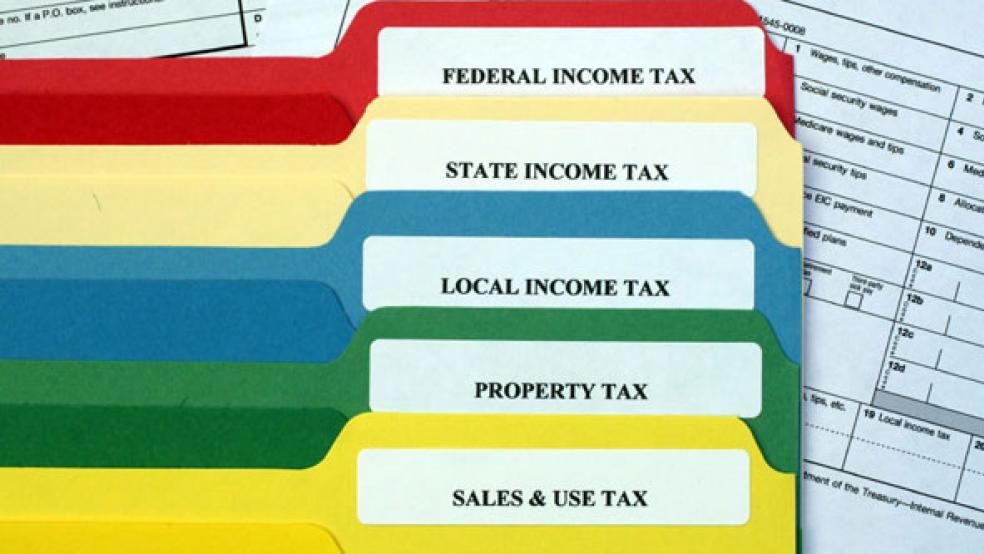
State taxes are once again making headlines. When California recently raised its top income tax rate to 13.3 percent, pro golfer Phil Mickelson threatened to leave the state for the no-income tax world of sunny Florida. Republicans in several states are pushing to abolish their income taxes and replace them with sales and other taxes deemed less burdensome to economic growth. And low-tax states like Texas have become more aggressive in their efforts to poach business and high-income individuals from places like California.
While at first glance, it would seem that people and businesses must be highly sensitive to state taxes, economic theory and data do not show that population, jobs and economic growth automatically favor low-tax states or make high-tax states uncompetitive.
To begin with, let’s look at state income tax rates. As one can see, California has the highest top rate and there are 7 states with no income tax at all.
While lately, some states with no income taxes such as Texas have done better in terms of jobs and growth than high-tax states such as California, it would be a mistake to look only at very recent trends and to ignore other explanations for changes in the economy, jobs and population. According to the Institute on Taxation and Economic Policy, there has been little relationship between state growth rates and state income tax burdens over the last decade.
California, for example, has long been a high-tax state. One reason is that when Ronald Reagan was governor from 1966 to 1974, he enacted some of the largest tax increases in the history of any state. Conservatives today like to forget that his first year in office in 1967 he proposed and enacted a tax increase equal to one-third of state revenue. Reagan proposed another large tax increase in 1970 that was substantially enacted in 1971. During his administration, California’s top income tax rate rose from 7 percent to 11 percent and the sales tax rate doubled from 3 percent to 6 percent, among other things. State revenues tripled during Reagan’s governorship from $2.9 billion to $8.6 billion over 8 years. Yet during the postwar era, California has been our fastest growing state.
Housing analyst Jed Kolko also points out that those leaving California between 2005 and 2009 weren’t high-income households sensitive to income tax rates, but low-income families that were more likely pushed out by high home prices.
Moreover, southern states have long had low taxes, in part a legacy of segregation which discouraged state spending on education, welfare and public services that would benefit African Americans. Although these states have improved a great deal in the era since enactment of the Civil Rights Act of 1964, they still have the highest rate of poverty, the highest percentage of people without health insurance and the lowest median income of any region, according to the Census Bureau.
Additionally, looking only at tax data tells us nothing about the services that governments provide. Some people, such as those without children, may care nothing about the quality of local schools and prefer to live where taxes are low and the quality of schools is poor. Those with children may be happy to pay more taxes in order to live in a community with good public schools and save themselves the expense of paying for private schools.
And of course, people often choose where to live because their professions require a particular location or because amenities, such as pleasant weather, are more important than the tax savings they could achieve by living in, say, Alaska.
But probably the most important factor that is overlooked by those who focus only on income taxes is that there are lots of other taxes imposed by state and local governments. States without income taxes have to get their revenue somewhere and often have much higher sales, auto and property taxes as a consequence.
The city of Washington, DC, annually produces data that compare tax burdens in other cities at different income levels, looking at all the taxes families pay. The table below is from the latest report, covering 2011. The data show the total tax rate, including all taxes, for a family of three with an income of $150,000. The percentages are for the largest city in each state and may include income and other taxes that do not apply elsewhere in the state.
New York City has the highest income tax burden of any major city, but its property tax rate is about a third of that in neighboring Newark, New Jersey, and less than one would pay in Anchorage, Alaska. People in Phoenix, Arizona, have low property and income taxes, but bear the heaviest sales tax burden in the nation, twice the national average.
Lastly, these data don’t show taxes paid by businesses, which may be dramatically different than taxes on individuals. According to the Council on State Taxation, in 2011, Alaska had the heaviest business tax burden of any state, consuming 15.4 percent of the private sector’s gross state product. By contrast, business taxes in California are close to the U.S. national average and consume just 5.3 percent of gross state product. Obviously, if high business taxes discourage economic growth and job creation, a state’s citizens may benefit little from low personal taxes.
The point is that assessing a state’s tax climate depends a lot on what a family or business cares about when deciding to locate there. It’s simplistic to look at one metric, the top income tax rate, and assume that this is the dominant indicator of a state’s tax, business or economic climate. Many other factors also come into play.
How does your state compare up on taxes? See the sortable chart below.
State | State Income tax rate | Effective Rate on a Typical Family of 3, HHI $150,000 | |
|---|---|---|---|
California | 13.3 | 10.5 | |
Hawaii | 11 | 7.8 | |
Oregon | 9.9 | 10 | |
Iowa | 8.98 | 9.1 | |
New Jersey | 8.97 | 10.7 | |
District of Columbia | 8.95 | 8.8 | |
Vermont | 8.95 | 8.7 | |
New York | 8.82 | 12.5 | |
Maine | 8 | 11 | |
Minnesota | 7.85 | 9.6 | |
North Carolina | 7.75 | 9.8 | |
Wisconsin | 7.75 | 10.3 | |
Idaho | 7.4 | 9.5 | |
Arkansas | 7 | 9 | |
South Carolina | 7 | 8.9 | |
Montana | 6.9 | 7.4 | |
Nebraska | 6.84 | 9.4 | |
Delaware | 6.75 | 9.3 | |
Connecticut | 6.7 | 15.7 | |
West Virginia | 6.5 | 8.9 | |
Tennessee | 6 | 4.3 | |
Georgia | 6 | 9.1 | |
Kentucky | 6 | 12 | |
Louisiana | 6 | 6.7 | |
Missouri | 6 | 9.9 | |
Rhode Island | 5.99 | 9.4 | |
Ohio | 5.925 | 12.2 | |
Maryland | 5.75 | 11.4 | |
Virginia | 5.75 | 8.2 | |
Massachusetts | 5.25 | 8.9 | |
Oklahoma | 5.25 | 7.8 | |
New Hampshire | 5 | 4.4 | |
Alabama | 5 | 8.6 | |
Illinois | 5 | 9.9 | |
Mississippi | 5 | 9.4 | |
Utah | 5 | 8.8 | |
Kansas | 4.9 | 8.7 | |
New Mexico | 4.9 | 8.2 | |
Colorado | 4.63 | 7.2 | |
Arizona | 4.54 | 7.2 | |
Michigan | 4.25 | 10.3 | |
North Dakota | 3.99 | 5.3 | |
Indiana | 3.4 | 8.7 | |
Pennsylvania | 3.07 | 13.3 | |
Alaska | 0 | 3.4 | |
Florida | 0 | 4.3 | |
Nevada | 0 | 4.2 | |
South Dakota | 0 | 4.8 | |
Texas | 0 | 4.4 | |
West Virginia | 0 | 5.1 | |
Sources: Federation of Tax Administrators and Office of the Chief Financial Officer | |||





